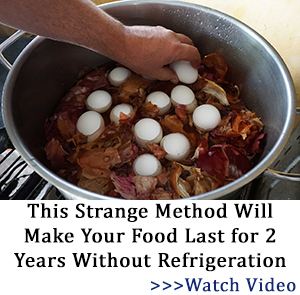How to Preserve Eggs In Water Glassing For Long-Term Storage
Posted by admin on
Are you looking for a method for preserving eggs in their whole raw form? If so, water glassing eggs is the most efficient long-term method available.
Water Glassing Eggs
As poultry keepers, there is one thing we can always count on: the drop in egg production between fall through early spring. We become frustrated about the lack of eggs available and wonder why we did not prepare for this season. Well, wonder no more! Learn the technique our great-grandparents used to store eggs before there were refrigerators, freezers, freeze-dryers, and dehydrators.
This method is known as “water glassing” eggs. Preserving eggs in this fashion allows farm-fresh eggs to be preserved whole in their rawest form, shell and all. Water glassing eggs allows the eggs to be consumed as if they were collected that same day.
Preserving eggs utilizing the water glassing method allows farm-fresh eggs to remain fresh between one year to 18 months. However, there are individuals who state their eggs remain edible for up to two years in the preserving liquid. The method of water glassing eggs has been practiced since the early 1800s. A popular 1886 cookbook publication, The Boston Cooking School Cookbook by Fannie Farmer, provided instructions on water glassing eggs in a lime solution as a means for preserving them long-term.
However, not all eggs can be preserved using the water glassing technique. This preserving technique is reserved for those who raise poultry or for individuals who have the opportunity to purchase farm fresh eggs.
Luckily, the steps for water glassing eggs are extremely easy, and you will be thankful for the ability and knowledge to preserve eggs when egg production was high. You will be especially thankful to have eggs during the winter months when egg production is low.
Water Glassing Eggs Long-Term
As previously mentioned, not all eggs will do. Eggs used for water glassing must be freshly laid and unwashed with the bloom intact. Unfortunately, market eggs have been washed, bleached, and more times than not, coated with mineral oil. The USDA requires egg cartons to be stamped with the package date, which consists of three numbers near the sell-by date. These numbers indicate the day of the year in which the eggs were packaged. However, the package date does not include the number of days between the egg being laid to the package date. With that said, the consumer can expect eggs to be many weeks old prior to purchasing them.
Eggs that are to be preserved long-term must not only be unwashed, they must also be very clean: free of dirt, debris, waste, or remnants of yolk, egg whites, or broken shell fragments. Do not attempt to wipe the eggs clean; this could remove the bloom. For best practices, select the cleanest eggs from the current day. Plan to add freshly collected eggs each day to the preserving bucket; this allows you to be selective with the eggs you preserve.

Preserving Bucket
Food grade buckets are ideal containers to use for water glassing eggs. Five-gallon buckets are popular, however, I find them to be difficult to work with. A three-gallon bucket will hold up to 80 eggs as well as the preserving liquid. Another means for calculating the desired bucket size: one quart of water glass will cover roughly 15 to 16 eggs. Keep in mind, three-gallon buckets can be easily moved, whereas a five-gallon buck is much heavier. Not to mention, withdrawing preserved eggs for use means reaching to the bottom of the bucket to pull older eggs first, making this task difficult in a five-gallon bucket. In addition to food-grade buckets, modern earthenware ceramic crocks are a popular choice.
Preserving Materials
wo types of material can be used to water glass eggs: sodium silicate and lime (calcium hydroxide). The type of lime to use is known as pickling lime, hydrated lime, and slaked lime. Both products are harsh on the skin and should be used cautiously; however, they both do an excellent job sealing the eggshell in order to preserve eggs long-term.
Sodium silicate is a food-grade chemical material and commonly used to seal concrete surfaces. Lime is a more natural substance and a lot more comfortable for people to use. For this recipe, we are going to use pickling lime which is found in the canning section of your local market.
Water
It is best to use water which is free of chlorine, fluoride, and high in minerals. Distilled water or natural spring water are the best options for water glassing eggs. If your city does add chlorine to the water, boil the water and allow it to cool completely before using it.
Equipment
Water Glassing Eggs: How-To
- 3-gallon food-grade bucket
Ingredients
- 5 ounces hydrated lime (pickling lime)
- 5 quarts distilled water or natural spring water
- fresh eggs, clean and unwashed
Instructions
- In a three-gallon bucket add an equal ratio of water to lime. Five quarts water to five ounces of lime provides enough room for the eggs to be submerged. Use the ratio of one quart of water to one ounce of lime regardless of the container size.
- Mix the pickling lime and water until completely dissolved.
- Next, gently add eggs to the liquid. Add pointy side downs allowing the air cells to remain at the tops of the eggs.
- Securely add the lid to the bucket to prevent the liquid from evaporating and the eggs from becoming exposed to air. Store the water glass eggs in a cool dark location, withdrawing eggs as needed, and wash well prior to using.
Pulling eggs from the bottom of the bucket allows you to use the oldest eggs first. However, pulling a small amount to be used within a few days saves from having to withdraw an egg each time you need one. Make sure to store these eggs in the refrigerator until ready to use.

Books can be your best pre-collapse investment.
Carnivore’s Bible (is a wellknown meat processor providing custom meat processing services locally andacross the state of Montana and more. Whether your needs are for domestic meator wild game meat processing)
The Lost Book of Remedies PDF ( contains a series of medicinal andherbal recipes to make home made remedies from medicinal plants and herbs.Chromic diseases and maladies can be overcome by taking the remediesoutlined in this book. The writer claims that his grandfather was taughtherbalism and healing whilst in active service during world war twoand that he has treated many soldiers with his home made cures. )
Easy Cellar(Info about building and managing your root cellar, plus printable plans. The book on building and using root cellars – The Complete Root Cellar Book.)
The Lost Ways (Learn the long forgotten secrets that helped our forefathers survive famines,wars,economic crisis and anything else life threw at them)
LOST WAYS 2 ( Wordof the day: Prepare! And do it the old fashion way, like our fore-fathers did it and succeed longbefore us,because what lies ahead of us will require all the help we can get. Watch this video and learn the 3 skills that ensured our ancestors survival in hard times offamine and war.)
The post How to Preserve Eggs In Water Glassing For Long-Term Storage appeared first on PrepperFortress.

